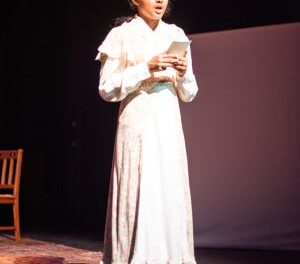The first concert of the 2012-13 season of the Greensboro Symphony’s Rice Toyota Sitkovetsky and Friends series strayed from the usual fare. Instead of several small chamber pieces, the evening featured the UNC-Greensboro chamber orchestra, Camerata Ensemble, a professional-level faculty/student string ensemble composed of approximately 17 players. UNCG faculty who play in and mentor the group include Marjorie Bagley and Fabian Lopez (violins), Scott Rawls (viola), and Alexander Ezerman (cello).
GSO Music Director Dmitry Sitkovetsky, as usual, served as MC, introducing each work and telling colorful background information. He explained that although the Camerata is usually conductorless, the ensemble allowed itself to be led by Sitkovetsky in his own arrangement of Ernst von Dohnányi’s Serenade in C Major for String Trio (1902).
The first movement Marcia (Allegro) was sprightly played, and the middle section, with its drones, provided a Hungarian flavor. The Romanza (Adagio non troppo) opened with an exquisitely played viola solo by Rawls over pizzicato strings. The vivace Scherzo’s scurrying strings were mostly together. The fourth movement Andante is a lengthy theme and variations and serves as the emotional heart of the entire composition; the ensemble played this beautifully. The rondo finale is dancelike and, like the opening movement, features a Hungarian tune. The arrangement was a delight and works well for a string orchestra.
The Concerto for Clarinet and Harp by Jakov Jakoulov (b. 1958) featured Kelly Burke and Helen Rifas (harp) with the Camerata Ensemble conducted by Sitkovetsky. This three-movement work, which was commissioned by and dedicated to Burke, is a fresh piece, and places considerable demands on both the musicians and the audience.
It begins with hushed harp sounds, which are eventually joined by low murmuring from the clarinet. Agitated, nervous strings soon join in. According to the composer’s notes (who was present for the premiere) the outer two movements are “grotesque-like intermezzos.”
The middle movement, titled “Pastoral” is “a depiction of a lonely shout along with wild and hostile nature.” The movement is “perfectly illustrated” by the poem “The Hawk’s Cry in Autumn” by Joseph Brodsky, which was an insert in the playbill.
Indeed, harmonics from some of the strings provided an eerie texture into which other strings ventured with hesitant, stuttering entrances. Then the mood changed with passages that featured extended techniques such as the clarinet bending pitches and the strings players using the wood of the bow for special effects. The final movement is dance-like with the harp moving with more consistent activity.
Ensemble between the players was excellent. Burke’s and Rifas’ playing certainly delighted the composer; and the entire composition was a hit with the audience.
Next was a string quartet arrangement of several sections from A Future of Tango, a concerto for saxophone quartet and orchestra composed in 2010 by UNCG composition faculty member Alejandro Rutty (b. 1967). The faculty quartet from the Camerata served up a hearty foray into what the tango might sound like in the future. Superb playing by all four members assured a winning performance for this delightful Medley.
The evening closed with Souvenir d’un lieu cher (“Memory of a Dear Place”) by Tchaikovsky. Although originally written for violin and piano, Alexander Glazunov arranged the piece for solo violin and orchestra, perfectly suiting Sitkovetsky and the Camerata. Beautiful and engaged playing characterized the entire performance, with the spotlight clearly on Sitkovetsky, who worked his usual magic on the violin.
The opening Méditation is cast in an ABA form with a melancholic violin melody in a minor key and low register surrounding a sweeter middle section. The fiendish second-movement Scherzo, again in ternary form, put both Sitkovetsky and the string ensemble through the paces. A beautiful, passionate violin tune provided contrast in the middle section. A wistful, pensive, but lyric melody provides the basis of the concluding Mélodie; the entire work ends with whisper.











